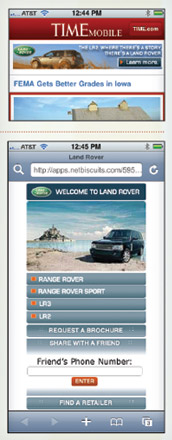 Mobile Marketing
Mobile Marketing
Mobile phones have long been a convenience for individuals; the ability to make phone calls, wherever and whenever the need (or in most cases, want) arises, has long been seductive to many. But as time and technology progress, the mobile phone is no longer just for making calls. Not only are our mobiles becoming an extension of our lives, they are coming into their own, their new features brimming with marketing potential — low-cost to utilize and high on return on investment. And with mobile phones predicted to reach 4 billion subscribers by 2010, this is a channel that companies can’t ignore.
 SMS/MMS
SMS/MMS
The most common form of mobile marketing is SMS, which stands for Short Message Service, otherwise known as text messaging. MMS stands for Multimedia Message Service – text messaging with multimedia capabilities. Even the most basic of the current batch of mobile phones support the sending and receiving of text messages. Because of the immediacy and simplicity of the medium, SMS is an excellent tool to reach an audience no matter where they are and can encourage immediate interaction with potential customers (your audience doesn’t have to go back to their computer).
After debating how best to reach the 18- to 34-year-old target audience in the Houston area, Popeyes® Chicken & Biscuits built an SMS campaign to boost sales. For under $5000 dollars, Popeyes developed a measurable, month-long campaign that would send coupons and special offers to customers who opted in to the program. The resulting efforts caused area Popeyes restaurants to see a sizeable increase in business on slower days (specifically Tuesdays), and even went viral as participants forwarded their SMS messages so their friends could opt in as well.
Beginning in 2006, the NCAA® Men’s College World Series has been sending subscribers SMS updates on scores, ticket availability and weather forecasts, as well as information regarding special events such as the Opening Ceremony concerts and player autograph signings. In 2007, Bozell saw a 34% increase in subscribers and a 62% increase for the 2008 games, making SMS a critical part of the communications, as visiting fans on the go relied on the updates for their day-to-day planning on their vacation to The Greatest Show on Dirt®.
 Mobile Web
Mobile Web
Another way businesses can reach consumers is through the mobile Web. In a July 2008 report, the Nielsen Company claims the mobile Web has reached critical mass as an advertising medium, with over 40 million active users surfing the Internet with their mobile device. Out of that figure, 26 percent are comfortable with and remember advertising from their mobile experiences, and 60% are more likely to be open to advertising than the average mobile user. Most phones have a rudimentary Web browser built into their feature set (the iPhone’s Mobile Safari browser being the most advanced) that can access online content. In some cases, making your existing website mobile-ready is easy: if your site has been coded to existing Web standards, congratulations — your site is accessible from mobile phones. However, some companies may want to offer specific mobile content to devices by building websites optimized for the smaller medium. The content on these mobile-specific sites should allow users to be able to navigate quickly to the information they are looking for, and more importantly can be utilized to display advertising. Conversely, advertisers can look at utilizing existing mobile sites’ ad space to learn how to drive potential customers to your company’s specific mobile campaign site. For example, the mobile version of Time.com recently featured an ad on their articles featuring the Land Rover. Clicking on this ad took users to a mobile-specific Land Rover site, where potential customers could browse the Land Rover model line, request a brochure, find a retailer and also highlight a “send to a friend” feature that allowed the user to input a friend’s phone number, letting the campaign grow virally.
What You Can Do Now
With carrier networks expanding into 3G speeds of data connectivity, advertisers can look to the day they can use streaming media and downloadable content such as wallpapers and ringtones as an integral part of their mobile marketing toolset. Regardless of these technology upgrades, marketers can quickly and cheaply adjust their strategies to include simple mobile campaigns with mobile websites and SMS. Companies should expect their first few campaigns to be fact-finding missions as they discover what does and doesn’t work in these new channels, but with entries into mobile having such a low impact on their budgets, mobile marketing becomes an attractive option for one-to-one communications with audiences.


